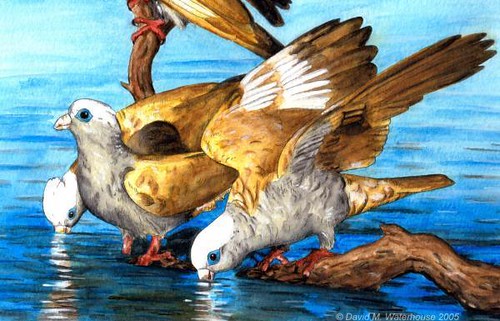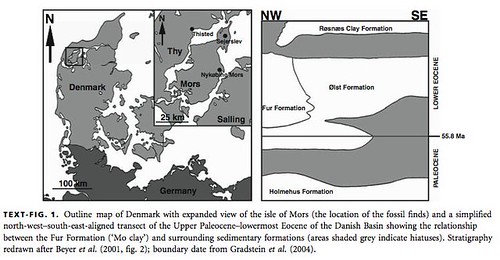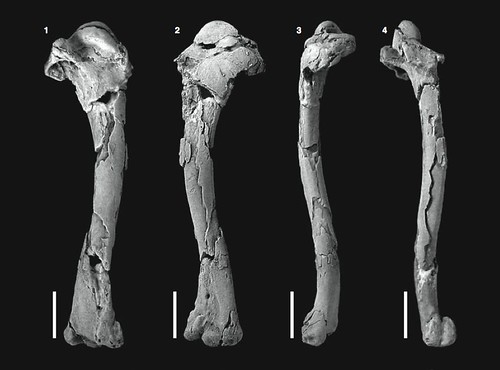tags: researchblogging.org, Aves, Psittaciformes, Pseudasturidae, parrots, Palaeogene, Eocene, Denmark
An artist's impression of the parrot-like bird, Mopsitta tanta, dating back 55 million years. The fossils indicate that parrots once flew wild over what is now Norway and Denmark.
Image: David Waterhouse [larger view].
A team of researchers, including a former postdoctoral colleague of mine, recently described fossils from two Lower Eocene parrot-like birds that were discovered in Denmark. The analysis of the fossils reveals that one of the ancient parrots, named Mopsitta tanta, is the largest fossil parrot found so far and it has the most northerly distribution yet known. Intriguingly, Mopsitta tanta predates the earliest unequivocal European psittacid by 30 million years!
Parrots are birds consisting of roughly 350 species in 85 genera within the order Psittaciformes. They occur throughout most warm and tropical regions at or near the equator. The diversity of South American and Australasian parrots originally suggested that these birds originated on Gondwana. However, the fossil record for parrots is sparse and their evolutionary origin remains a matter of informed speculation.
Two fossil bones were discovered eight years ago by Bent Søe Mikkelsen in a quarry on the isle of Mors in Jutland, Denmark, which is located on the North Sea (see figure 1, below). Mikkelsen is the former director of the Moler Museum where these fossils are now housed. Amazingly, this quarry is mined to produce cat litter!
"As with many fragile bird fossils, it is a wonder that anything remains at all, and all that remains of this early Danish parrot is a single upper wing bone (humerus)." (See plates 1-4, below);
Plates 1-4 Mopsitta tanta gen. et sp. nov.; FU 110 â 139, holotype from the Lower Eocene Fur Formation, Denmark; digital photographs of right humerus (coated in ammonium chloride to enhance contrast) in 1, caudal, 2, cranial, 3, right lateral and 4, left lateral views [larger view].
"Obviously, we are dealing with a bird that is bereft of life, but the tricky bit is establishing that it was a parrot," said David Waterhouse, lead author of the paper. But meticulous analysis of the small bone revealed that it is indeed from a parrot.
"This small bone contains characteristic features that show that it is clearly from a member of the parrot family, about the size of a Yellow-crested Cockatoo," [Cacatua sulphurea], said Waterhouse, who originally identified the bone in 2005, when he was a PhD student at University College Dublin. The 5-6 centimeter bone had lain unidentified in the Moler Museum for several years when he first examined it (See Waterhouse's drawings below);
[larger view].
The new species has been nicknamed the Danish Blue Parrot in honor of the Monty Python "dead parrot" skit where Michael Palin claimed that a newly purchased "Norwegian Blue Parrot" was not "bleedin' demised" as his disgruntled customer asserted, but was simply "shagged out following a prolonged squawk."
This Mopsitta tanta fossil humerus provides support for the hypothesis that modern parrots appeared approximately ten million years after the K/T boundary.
"We have to remember that this was only ten million years after the dinosaurs were wiped out, and some strange things were happening with animal life all over the planet."
The evidence shows that the Danish Blue parrot existed 55 million years ago, suggesting they lived alongside other contemporary Psittaciforms; the Pseudasturidae and Quercypsittacidae. However, even though this fossil suggests this was a modern parrot, research suggests that the Danish Blue would have looked different from today's parrots, especially since it probably lacked a parrot's familiar hooked bill.
This fossil is also the farthest north that any parrot remains have been found, suggesting that parrots originally evolved in the Old World, before moving into the southern tropics of the New World and further speciating.
"It isn't as unbelievable as you might at first think that a parrot was found so far north," Waterhouse observed. "When Mopsitta was alive, most of Northern Europe was experiencing a warm period, with a large, shallow tropical lagoon covering much of Germany, southeast England and Denmark."
Because this fossil humerus raises a host of new questions without answering any of them, it would be most interesting and informative if a tarsometatarsus and/or some cranial fossils could be uncovered in the near future.
Source
Waterhouse, D.M., Lindow, B.E., Zelenkov, N.V., Dyke, G.J. (2008). Two new parrots (Psittaciformes) from the Lower Eocene Fur Formation of Denmark. Palaeontology, 51(3), 575-582. DOI: 10.1111/j.1475-4983.2008.00777.x





So it's no surprise if they're pining for the fjords.
Pining for the fjORDS?!!!! What kind of talk is that? Clearly you're just parroting something you heard in a Monty Python Sketch...!
I love the way Grrlscientist has fitted as many variations on "Psitta-" into this article as can reasonably be squeezed. What a tongue-twisting blog entry!
Speaking from ignorance - is ten million years long enough to evolve a modern parrot from a dinosaur? Or are there known predecessors?
Inquiring minds want to know.
oldfart -- you do not speak from ignorance because "ignorance" implies this information is known by everyone but you. this is not the case, because NO ONE knows how long it takes to evolve a parrot from its basal dinosaur (or avian) lineage. not only that, but there are no known predecessors to this fossil that are clearly parrots. the reason this fossil is news is because it is the most parrot-like predecessor identified -- and it predates the next known parrot fossils by 30 million years!
While it's not impossible for parrots to survive at relatively high latitudes (Antipodes Island Parrot, south of New Zealand at almost 50° S., Monk Parakeets in Chicago, various species in San Francisco), it's certainly not common.
However, it seems like an unlikely conjecture that parrots might have originated in Europe. Far more likely, it seems to me, is that during a previous, warm, interglacial period, they ranged further north than they do now. When the next ice age appeared, the parrots would have retreated to the more habitable tropics, the likely land of their origin.
What evidence is to support the statement that "it probably lacked a parrot's familiar hooked bill"? If it wasn't a fruit-eater, then might it have survived by eating flesh, seeds (pine nuts, perhaps, like a crossbill?) or invertebrates? A lack of dependency on fruit might enhance survival in colder climes.
OK, I don't know, but it's possible that a previously sketched parrot didn't have one.
It's too bad these fossils weren't discovered in time for Al Gore's movie. He could have pointed out the horrific implications: if global warming continues, parrots will invade Denmark again! We must stop them! Our environmentally-conscious Eocene forebears stopped driving their SUVs and drove the parrots out---we can do no less!
Okay, I'm going to attempt to answer a few of the queries that have arisen here. Firstly, birds evolved a long time before the extinction of the dinosaurs and lived alongside each other for about 85 million years (Archaeopteryx the earliest known fossil bird is about 150 million years old - Jurassic). It was from a similar ancestor that all birds (including the parrots) evolved from. Secondly, Mopsitta does not predate the next known fossil parrot by 30 million years. Other fossil parrots have been found in slightly younger deposits in Germany dating from about 50 million years ago.
One hypothesis about parrot evolution is that their origins lay in what is now Europe. This is just a hypothesis, but as no southern hemisphere parrots have been found older than the Middle Miocene (about 15 million years old) - this is the most likely hypothesis at the moment. The vast majority of fossil parrot material is from Europe.
The evidence for the statement, "it probably lacked a parrot's familiar hooked bill" is from close, but younger fossil parrot relatives. We know that Psittacopes (a parrot from the Lower Middle Eocene of Germany) had a rather finch-like bill. We do not see any evidence for hooked bills until much later in the fossil record. However, these early parrots did have the distinctive zygodactyl feet that modern parrots possess.
There! You went and made me look up zygodactyl!
Fascinating stuff.
Slight correction: it was John Cleese claiming the parrot wasn't dead. He was the shopkeeper. Michael Palin was the customer.
I know. Sorry. Sorry.
Oh god. No it wasn't.
Just ignore that comment.
Honestly!
Oh, you are so gloriously naive, you who belong to the church of the latter day evolutionists. Parrots from dinosaurs!! Ha-ha!! This dumbass european mythology has no root in neither experience nor reality. His Bobness sings: When are you gonna wake up and strengthen the things that remain? A good place to start would be with (the humean atheist) David Stove's brilliantly funny and penetratingly intelligent book "Darwinian Fairytales", after which there is no more Darwin for any thinking human being. In a decade or two this will be as obvious even to mainstream taxidrivers as the opposite is to them now after listening to people like you for a century or so. If you want to live in the land of myths, why don't you go all the way back to the old greeks? Then you can let go also of the thin layer of pseodo scientific colours with which the myth of evolution is painted and flout freely in the space of subjective projections. I dare you guys to come up with one single shred of evidence that there ever was a (macro)evolution. One. Darwin is as dead as the parrot. (From one awakened intellectual who do not suffer fools gladly)